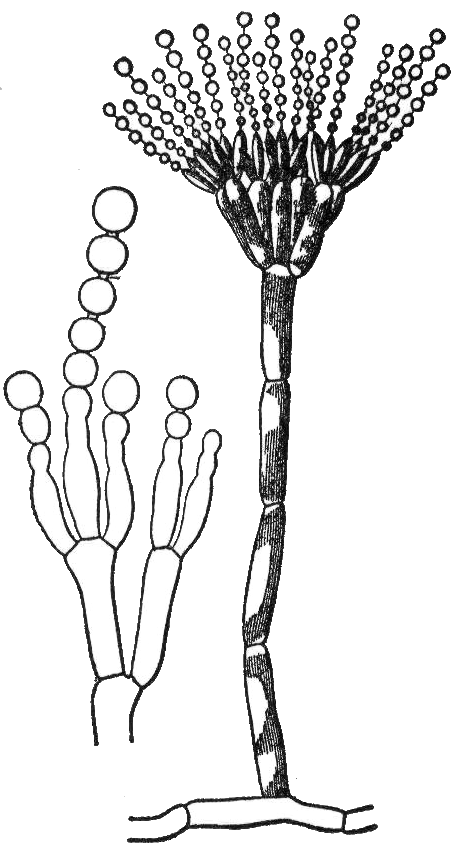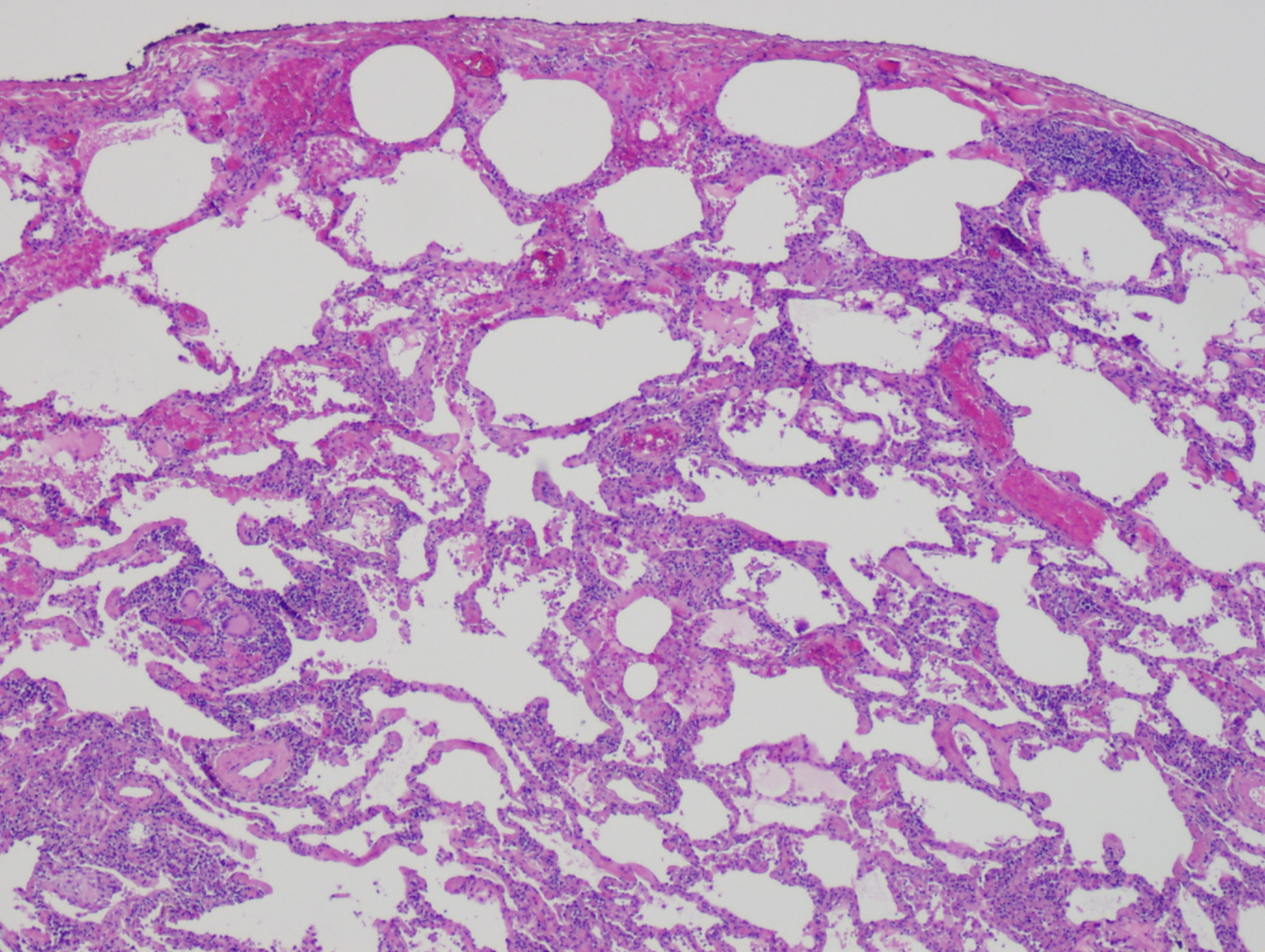|
Conidiophore
A conidium ( ; : conidia), sometimes termed an asexual chlamydospore or chlamydoconidium (: chlamydoconidia), is an Asexual reproduction, asexual, non-motility, motile spore of a fungus. The word ''conidium'' comes from the Ancient Greek word for dust, ('). They are also called mitospores due to the way they are generated through the cellular process of mitosis. They are produced exogenously. The two new haploid cells are genetically identical to the haploid parent, and can develop into new organisms if conditions are favorable, and serve in biological dispersal. Asexual reproduction in ascomycetes (the phylum Ascomycota) is by the formation of conidia, which are borne on specialized stalks called conidiophores. The Morphology (biology), morphology of these specialized conidiophores is often distinctive between species and, before the development of molecular techniques at the end of the 20th century, was widely used for identification of (''e.g.'' ''Metarhizium#Species, Metarh ... [...More Info...] [...Related Items...] OR: [Wikipedia] [Google] [Baidu] |
Ascomycota
Ascomycota is a phylum of the kingdom Fungi that, together with the Basidiomycota, forms the subkingdom Dikarya. Its members are commonly known as the sac fungi or ascomycetes. It is the largest phylum of Fungi, with over 64,000 species. The defining feature of this fungal group is the "ascus" (), a microscopic sexual reproduction, sexual structure in which nonmotile spores, called ascospores, are formed. However, some species of Ascomycota are Asexual reproduction, asexual and thus do not form asci or ascospores. Familiar examples of sac fungi include morels, truffles, yeast#Beer, brewers' and bakers' yeast, Xylaria, dead man's fingers, and cup fungi. The fungal symbionts in the majority of lichens (loosely termed "ascolichens") such as ''Cladonia'' belong to the Ascomycota. Ascomycota is a monophyletic group (containing all of the descendants of a common ancestor). Previously placed in the Basidiomycota along with asexual species from other fungal taxa, asexual (or Teleomorph, ... [...More Info...] [...Related Items...] OR: [Wikipedia] [Google] [Baidu] |
Fungus
A fungus (: fungi , , , or ; or funguses) is any member of the group of eukaryotic organisms that includes microorganisms such as yeasts and mold (fungus), molds, as well as the more familiar mushrooms. These organisms are classified as one of the kingdom (biology)#Six kingdoms (1998), traditional eukaryotic kingdoms, along with Animalia, Plantae, and either Protista or Protozoa and Chromista. A characteristic that places fungi in a different kingdom from plants, bacteria, and some protists is chitin in their cell walls. Fungi, like animals, are heterotrophs; they acquire their food by absorbing dissolved molecules, typically by secreting digestive enzymes into their environment. Fungi do not photosynthesize. Growth is their means of motility, mobility, except for spores (a few of which are flagellated), which may travel through the air or water. Fungi are the principal decomposers in ecological systems. These and other differences place fungi in a single group of related o ... [...More Info...] [...Related Items...] OR: [Wikipedia] [Google] [Baidu] |
Conidium
A conidium ( ; : conidia), sometimes termed an asexual chlamydospore or chlamydoconidium (: chlamydoconidia), is an Asexual reproduction, asexual, non-motility, motile spore of a fungus. The word ''conidium'' comes from the Ancient Greek word for dust, ('). They are also called mitospores due to the way they are generated through the cellular process of mitosis. They are produced exogenously. The two new haploid cells are genetically identical to the haploid parent, and can develop into new organisms if conditions are favorable, and serve in biological dispersal. Asexual reproduction in ascomycetes (the phylum Ascomycota) is by the formation of conidia, which are borne on specialized stalks called conidiophores. The Morphology (biology), morphology of these specialized conidiophores is often distinctive between species and, before the development of molecular techniques at the end of the 20th century, was widely used for identification of (''e.g.'' ''Metarhizium#Species, Metarh ... [...More Info...] [...Related Items...] OR: [Wikipedia] [Google] [Baidu] |
Epidermis (botany)
The epidermis (from the Greek language, Greek ''ἐπιδερμίς'', meaning "over-skin") is a single layer of cells that covers the leaf, leaves, flowers, roots and Plant stem, stems of plants. It forms a boundary between the plant and the external environment. The epidermis serves several functions: it protects against water loss, regulates gas exchange, secretes metabolic compounds, and (especially in roots) absorbs water and mineral nutrients. The epidermis of most leaves shows Anatomical terms of location#Dorsal and ventral, dorsoventral anatomy: the upper (adaxial) and lower (abaxial) surfaces have somewhat different construction and may serve different functions. Woody stems and some other stem structures such as potato tubers produce a secondary covering called the periderm that replaces the epidermis as the protective covering. Description The epidermis is the outermost cell layer of the primary plant body. In some older works the cells of the leaf epidermis have been ... [...More Info...] [...Related Items...] OR: [Wikipedia] [Google] [Baidu] |
Mycelia
Mycelium (: mycelia) is a root-like structure of a fungus consisting of a mass of branching, thread-like hyphae. Its normal form is that of branched, slender, entangled, anastomosing, hyaline threads. Fungal colonies composed of mycelium are found in and on soil and many other substrates. A typical single spore germinates into a monokaryotic mycelium, which cannot reproduce sexually; when two compatible monokaryotic mycelia join and form a dikaryotic mycelium, that mycelium may form fruiting bodies such as mushroom A mushroom or toadstool is the fleshy, spore-bearing Sporocarp (fungi), fruiting body of a fungus, typically produced above ground on soil or another food source. ''Toadstool'' generally refers to a poisonous mushroom. The standard for the n ...s. A mycelium may be minute, forming a colony that is too small to see, or may grow to span thousands of acres as in ''Armillaria''. Through the mycelium, a fungus absorbs nutrients from its environment. It does thi ... [...More Info...] [...Related Items...] OR: [Wikipedia] [Google] [Baidu] |
Pycnidium
A pycnidium (plural pycnidia) is an asexual fruiting body produced by mitosporic fungi, for instance in the order Sphaeropsidales ( Deuteromycota, Coelomycetes) or order Pleosporales (Ascomycota, Dothideomycetes). It is often spherical or inversely pearshaped ( obpyriform) and its internal cavity is lined with conidiophore A conidium ( ; : conidia), sometimes termed an asexual chlamydospore or chlamydoconidium (: chlamydoconidia), is an Asexual reproduction, asexual, non-motility, motile spore of a fungus. The word ''conidium'' comes from the Ancient Greek word f ...s. When ripe, an opening generally appears at the top, through which the pycnidiospores escape. References {{reflist Further reading *Kulik, Martin M. "Symptomless infection, persistence, and production of pycnidia in host and non-host plants by Phomopsis batatae, Phomopsis phaseoli, and Phomopsis sojae, and the taxonomic implications." Mycologia(1984): 274–291. *Calpouzos, L., and D. B. Lapis. "Effects ... [...More Info...] [...Related Items...] OR: [Wikipedia] [Google] [Baidu] |
Plant Cuticle
A plant cuticle is a protecting film covering the outermost skin layer (epidermis) of leaves, young shoots and other aerial plant organs (aerial here meaning all plant parts not embedded in soil or other substrate) that have no '' periderm''. The film consists of lipid and hydrocarbon polymers infused with wax, and is synthesized exclusively by the epidermal cells. Kolattukudy, PE (1996) Biosynthetic pathways of cutin and waxes, and their sensitivity to environmental stresses. In: Plant Cuticles. Ed. by G. Kerstiens, BIOS Scientific publishers Ltd., Oxford, pp 83-108 Description The plant cuticle is a layer of lipid polymers impregnated with waxes that is present on the outer surfaces of the primary organs of all vascular land plants. It is also present in the sporophyte generation of hornworts, and in both sporophyte and gametophyte generations of mosses. The plant cuticle forms a coherent outer covering of the plant that can be isolated intact by treating plant tissue with ... [...More Info...] [...Related Items...] OR: [Wikipedia] [Google] [Baidu] |
Hypersensitivity Pneumonitis
Hypersensitivity pneumonitis (HP) or extrinsic allergic alveolitis (EAA) is a syndrome caused by the repetitive inhalation of antigens from the environment in susceptible or sensitized people. Common antigens include molds, bacteria, bird droppings, bird feathers, agricultural dusts, bioaerosols and chemicals from paints or plastics. People affected by this type of lung inflammation ( pneumonitis) are commonly exposed to the antigens by their occupations, hobbies, the environment and animals. The inhaled antigens produce a hypersensitivity immune reaction causing inflammation of the airspaces ( alveoli) and small airways (bronchioles) within the lung. Hypersensitivity pneumonitis may eventually lead to interstitial lung disease. Signs and symptoms Hypersensitivity pneumonitis (HP) can be categorized as acute, subacute, and chronic based on the duration of the illness. Acute In the acute form of HP dose of antigen exposure tends to be very high but only for a short duration. Sym ... [...More Info...] [...Related Items...] OR: [Wikipedia] [Google] [Baidu] |
Cryptostroma Corticale
''Cryptostroma corticale'' is a species of fungus that causes sooty bark disease of maples, particularly sycamore (''Acer pseudoplatanus''). The spores grow profusely under the bark of affected trees or stacked logs. The fungus causes disease and death in trees, and the spores are allergenic and cause a debilitating pneumonitis (inflammation of the lungs) in humans. Taxonomy The fungus is thought to have originated in North America and was originally named ''Coniosporium corticale'' by the American mycologists Job Bicknell Ellis and Benjamin Matlack Everhart. The characteristics of the stroma, conidiophores and conidia was the basis for placing it in a new genus as ''Cryptostroma corticale''. It is the type species. Biology Sooty bark disease causes wilting of the crown and dieback of branches. Rectangular patches of bark, and later long strips of bark, become detached from the trunk exposing thick layers of black fungal spores. It has been found that the fungus spreads more r ... [...More Info...] [...Related Items...] OR: [Wikipedia] [Google] [Baidu] |
Germ Tube
A germ tube is an outgrowth produced by spores of spore-releasing fungi during germination. The germ tube differentiates, grows, and develops by mitosis to create somatic hyphae.C.J. Alexopolous, Charles W. Mims, M. Blackwell, ''Introductory Mycology, 4th ed.'' (John Wiley and Sons, Hoboken NJ, 2004) A germ tube test is a diagnostic test in which a sample of fungal spores are suspended in animal serum and examined by microscopy Microscopy is the technical field of using microscopes to view subjects too small to be seen with the naked eye (objects that are not within the resolution range of the normal eye). There are three well-known branches of microscopy: optical mic ... for the detection of any germ tubes.Chapter IV. Germ Tube Test iYEAST IDENTIFICATION document at doctorfungus.org. Retrieved July 2011 It is particularly indicated for colonies of white or cream color on fungal culture, where a positive germ tube test is strongly indicative of '' Candida albicans''. ... [...More Info...] [...Related Items...] OR: [Wikipedia] [Google] [Baidu] |
Immunocompromised
Immunodeficiency, also known as immunocompromise, is a state in which the immune system's ability to fight infectious diseases and cancer is compromised or entirely absent. Most cases are acquired ("secondary") due to extrinsic factors that affect the patient's immune system. Examples of these extrinsic factors include HIV infection and environmental factors, such as nutrition. Immunocompromisation may also be due to genetic diseases/flaws such as SCID. In clinical settings, immunosuppression by some drugs, such as steroids, can either be an adverse effect or the intended purpose of the treatment. Examples of such use is in organ transplant surgery as an anti- rejection measure and in patients with an overactive immune system, as in autoimmune diseases. Some people are born with intrinsic defects in their immune system, or primary immunodeficiency. A person who has an immunodeficiency of any kind is said to be immunocompromised. An immunocompromised individual may part ... [...More Info...] [...Related Items...] OR: [Wikipedia] [Google] [Baidu] |





